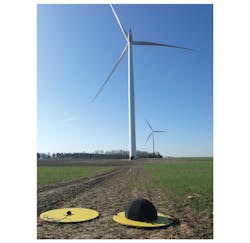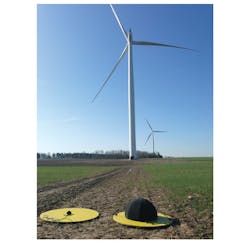Accredit Your Wind Turbine’s Noise Performance In Six Easy Steps
Wind power is a hot topic right now, as people seek green alternatives to fossil fuels. It is clean, affordable, and endlessly renewable. But it also has the potential to be noisy. Improperly designed or tuned wind turbines can generate an unpleasant amount of sound for people living nearby.
Related Articles
- The Wind Turbine Of The Future
- Wind Turbines Play In Paradise, But Not In Falmouth
- Innovative Designs Keep Power Turbines Spinning
Until recently, Canadian wind turbine operators could not easily have the noise levels of their equipment tested. Only a handful of companies in the U.S. and Europe are accredited to do this complex and exacting assessment, so testing was both slow and expensive.
That has changed now that Aercoustics Engineering Limited has achieved ISO 17025:2005 accreditation to conduct acoustic measurements of wind turbines in accordance with the International Electrotechnical Commission 61400-11 standard (see the figure). The Toronto organization is the only one in Canada able to certify noise levels from wind turbines.
This was the first accreditation sought by Aercoustics, and its accreditation inexperience coupled with the rigorous requirements of the process made this a challenging undertaking. Companies looking to achieve similar accreditation need to be prepared for the workload, attention to detail, and potential cultural change that will be required. As you embark on the accreditation process, keep six steps in mind.
This file type includes high resolution graphics and schematics when applicable.
1. Ensure Senior Managers Are On Board
The accreditation process requires a significant amount of work and a demanding devotion to detail. Before beginning, ensure anyone who will be affected by possible changes in policies and procedures is on your side. One of the key elements of the application is identifying and addressing deficiencies in documentation and process design, and this may require an organization to institute changes. Waiting for various managers to approve necessary changes will delay the application process.
2. Document All Processes
While Aercoustics was producing high-quality work and projects, being a smaller company meant documentation was not always the priority. As part of the ISO 17025 standard, companies must detail all steps and processes clearly, ranging from how documents and tenders are reviewed to how data is collected. Because of the time involved, smaller companies tend not to detail their processes to ISO standards. During and after the accreditation, every step and detail must be documented.
This required a cultural change for Aercoustics, a company that had prided itself on its anti-corporate atmosphere. For example, in the past when someone called for a quote, a person would simply be assigned to follow up as needed. This changed following accreditation, as there is now a checklist in place that outlines the steps that must take place before providing a quote.
The extra steps are time-consuming but ensure that any possible lapses in quality are caught early on. Aercoustics addressed the additional workload concerns by limiting these procedures to the section of the business that deals with the IEC standard. This means not all staff members have to operate under the rigorous documentation requirements.
3. Identify Deficiencies
Companies must complete an internal audit of relevant processes. An internal audit identifies potential problems in the management system and provides an opportunity to resolve the issues before the on-site assessment. Following the audit, the documentation is submitted to the Standards Council, which conducts a desktop study of the organization’s system to pinpoint any deficiencies.
The study goes through every clause of IEC 17025 and ensures all requirements have been met and documented. A case representative will then identify any areas that did not adhere to the standard. It’s important to note that finding deficiencies is normal. In fact, at the beginning of the process, the assessors said they have yet to find a lab that does not have a single deficiency. The key is being able to address and rectify the problems as needed.
4. Address Deficiencies
Deficiencies must be addressed immediately and corrective action taken. Some changes can be instituted easily. Others, like modifying training requirements or dealing with the financial requirements of compliance, may be more difficult.
The Standards Council will identify what needs to be addressed, but it’s up to the organization to determine how to meet those goals. Once this is completed, the company must explain in writing how the deficiencies have been addressed and provide any required supplemental documentation. If this is deemed sufficient, Standards Council staff will schedule an on-site inspection.
5. Prepare For The Site Visit
The size of the lab and the scope of the inspection work will determine how many people will attend the on-site assessment. For Aercoustics, one person was dedicated to the quality management process and one technical expert assessed a demonstration of the acoustic measurement procedure. It was a challenge for the Standards Council to find a technical assessor for this particular work because at the time no one in Canada was already accredited for acoustic measurement.
The quality assessor will interview individuals within the company to ensure policies are being followed, so it is imperative that employees are well versed on the rules and procedures, particularly as new ones come on board as part of the application process.
The Standards Council then identifies any additional deficiencies that need to be addressed. Certain deficiencies will need to be resolved before assessors can recommend accreditation. Others can be rectified before the reassessment takes place the following year.
6. Be Patient
Even if you are successful in the first attempt, the entire process can take up to a year. For Aercoustics, the process began at the beginning of December 2012 and ended with accreditation in October of 2013. If unsuccessful, a company can appeal the decision or re-apply.
Summary
Applying for accreditation is time consuming and often frustrating, as organizations scramble to identify and address all deficiencies and shift corporate culture to adopt new procedures. At the same time, accreditation comes with many benefits. It will enhance a company’s reputation, support data quality, and demonstrate the technical capability and expertise of the team. It may also provide organizations with the necessary edge to outbid other firms.
About the Author
Payam Ashtiani
Noise and Vibration Consultant and Principal
Payam Ashtiani, BASc, PEng, is a noise and vibration consultant and principal with Aercoustics Engineering Limited. His expertise is in the field of acoustics with a specific focus on noise from wind turbines. His experience includes wind farm noise modeling, prediction, measurement methodology, and data processing with various wind farms including Wolfe Island EcoPower Centre and McLean’s Mountain Wind farm in Ontario. In addition to completing numerous noise assessments for wind projects, and extensive wind turbine noise measurement campaigns, he has authored multiple research papers on the topic and presented at international technical conferences. He has also provided expert advice in the development of the Ontario Ministry of Environment’s compliance protocol for measuring wind turbine noise and has appeared as an expert witness in landmark cases such as the Kent Breeze Environmental Review Tribunal and the Bull Creek Wind Power AUC Hearing in Alberta. He has a bachelor’s degree in mechanical engineering from the University of Toronto. He can be reached at [email protected].



